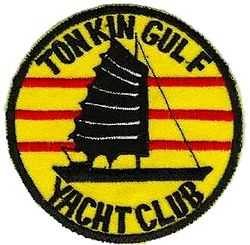Tonkin Gulf Yacht Club

Tonkin Gulf Yacht Club was a tongue-in-cheek nickname for the United States Seventh Fleet during the Vietnam War. All through the war in Vietnam, the Seventh Fleet engaged in combat operations against enemy forces through attack carrier air strikes, naval gunfire support, amphibious operations, patrol and reconnaissance operations and mine warfare.
Naval operations
US Naval forces had been introduced intermittently off the coast of Vietnam since March 1950 as "show the flag" tours to reinforce the Republic of Vietnam. In May of 1964 three carrier task groups took up position at Yankee Station in the Gulf of Tonkin. Reconnaissance flights were conducted by these carriers, although no combat missions had started. The Soviets had assisted the Vietnamese in the construction of more sophisticated anti-aircraft installations. The Navy sought to bring electronic warfare "DeSoto missions" to identify these installations and sent the USS Maddox (DD-731), leading to the Tonkin Gulf Incident.[1]
The number of vessels dramatically increased, with the "yacht club" including destroyers and cruisers along the coast on the gun line. After the 1973 cease-fire, the Fleet conducted mine countermeasure operations in the coastal waterways of North Vietnam. Two years later, ships and aircraft of the Fleet evacuated thousands of US citizens and refugees from South Vietnam and Cambodia as those countries fell to opposing forces. The fleet departed in 1975.
The nickname and logo
The name "Tonkin Gulf Yacht Club" was used from 1961 when the Seventh Fleet arrived to the waters off Vietnam. Much like the naval traditions of line-crossing ceremonies and plankowner certificates, the club served to commemorate sailors' participation in the campaign.[2] The qualifications for membership broadly construed to any service-member assigned to 7th Fleet, from the ships on the gun line, to aircraft sorties from the carriers, to riverine units, and Marines on the shore.[3] Although unofficial, the term became popular enough to be found in a declassified 1966 command history of the USS Enterprise, one of the vessels of Seventh Fleet.[4] The title and logo have been popular with veterans of Seventh Fleet's involvement in the Vietnam War.[5][6][7]
Citations
- ↑ Cavendish 1989, pp. 11-13.
- ↑ Beates, Chet (January 2009). Son of a Gun - The Life and Times of a Lifer Brat. Lulu. p. 70. ISBN 9781430325888. Retrieved 2014-07-06.
- ↑ Melson, Charles D.; Arnold, Curtis G. (1991). The War That Would Not End, 1971-1973. U.S. Marines In Vietnam. United States Marine Corps History and Museums Division. p. 188. LCCN 77604776.
- ↑ "NARRATIVE HISTORY OF THE USS ENTERPRISE (CVA(N)65) 1 JAN - 31 DEC 66" (PDF). United States Navy. 10 July 1967. p. 1.
The presence of USS Enterprise in the Gulf of Tonkin was well-known around the world by January 1966. Her own prestige as the largest and most powerful warship of the fleet had followed her to Yankee and Dixie Station, and there was more to the emerging legend than this; she and USS Bainbridge, her frigate "smallboy", had put a watershed date in naval history merely by being the first nuclear-powered ships to engage in combat. Their unmatched speed, detection systems, and operational capacity potential were proving their worth far beyond the original estimates during the first weeks "on the line at the Tonkin Gulf Yacht Club."
- ↑ "WETSU 66". Vietnamproject.ttu.edu. Retrieved 2014-07-06.
- ↑ Ames, Bruce. "Tonkin Gulf Yacht Club". San Joaquin Valley Veterans. Retrieved 2014-07-06.
- ↑ "Roster of Ships in the Tonkin Gulf Yacht Club". Oilchange.tripod.com. 2000-09-13. Retrieved 2014-07-06.
References
- The Vietnam War:War at Sea. New York: Marshall Cavendish. 1989. ISBN 0863078648.